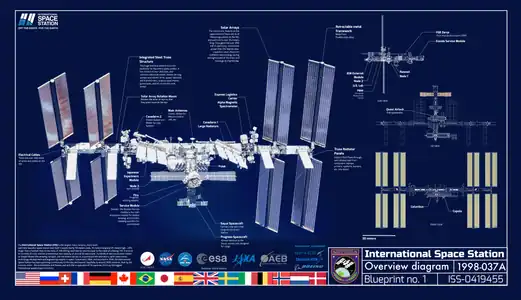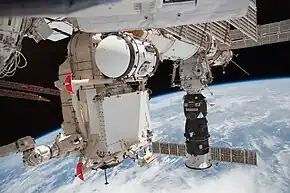 | |
| Module statistics | |
|---|---|
| COSPAR ID | 2010-079A |
| Launch date | 14 May 2010, 18:20:09 UTC |
| Launch vehicle | Space Shuttle Atlantis |
| Docked | 18 May 2010 |
| Mass | Empty: 5,075 kg Launch: 8,015 kg |
| Length | 6 m |
| Diameter | 2.35 m |
| Pressurised volume | Total: 17.4 m3 Pressurised: 5.85m3[1] |
Rassvet (Russian: Рассвет; lit. "first light"), also known as the Mini-Research Module 1 (MRM-1; Russian: Малый исследовательский модуль, МИМ 1) and formerly known as the Docking Cargo Module (DCM), is a component of the International Space Station (ISS). The module's design is similar to the Mir Docking Module launched on STS-74 in 1995. Rassvet is primarily used for cargo storage and as a docking port for visiting spacecraft. It was flown to the ISS aboard Space Shuttle Atlantis on the STS-132 mission on 14 May 2010,[2] and was connected to the ISS on 18 May 2010.[3] The hatch connecting Rassvet with the ISS was first opened on 20 May 2010.[4] On 28 June 2010, the Soyuz TMA-19 spacecraft performed the first docking with the module.[5]
Details
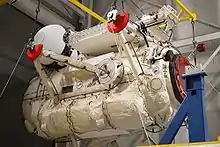

Rassvet was docked to the nadir port of Zarya with help from the Canadarm2.[6] Rassvet carried externally attached outfitting equipment from NASA for the Nauka Multipurpose Laboratory Module Upgrade (MLM-U), a spare elbow joint for the European Robotic Arm (ERA), an ERA portable workpost used during EVAs, heat radiator, internal hardware and Nauka's experiment airlock for launching cubesats. Delivering Rassvet thus enabled NASA to fulfill its promise to ship 1.4 metric tons to equip the MLM.[7]
Rassvet has two docking units: one to attach to the nadir port of the Zarya module, and one to provide a docking port for a Soyuz or Progress spacecraft. It implements the role of the Docking and Storage Module from the original ISS design. Russia announced the cancellation of the last of the two planned Russian Research Modules when it announced the plans for Rassvet.
Initial planning
The initial ISS plan included a Docking and Storage Module (DSM). This planned Russian element was intended to provide facilities for stowage and an additional docking port, and would have been launched to the station on a Proton launch vehicle. The DSM would have been mounted to Zarya's nadir (Earth-facing) docking port. It would have been similar in size and shape to the Zarya module.
The DSM was cancelled due to Russian budgetary constraints for some time, but its design was eventually modified into the Docking and Cargo Module (Rassvet) that was to be connected to the same Zarya location to provide storage space and a docking port. During the cancellation period, it was proposed that a Multi Purpose Module (MPM) called Enterprise should be docked to Zarya, and later the Nauka Multipurpose Laboratory Module (MLM) was proposed to be located there as well, but the Enterprise module has since been cancelled and the Nauka MLM was docked to Zvezda's nadir port instead.
Purpose
Rassvet was designed as a solution to two problems facing the ISS partners:
- NASA was under contract to carry the MLM outfitting equipment into space.
- The overlapping missions of the Progress, Soyuz, and ATV spacecraft highlighted the need to have four Russian docking ports available on the ISS. The cancellation of both Russian Research Modules meant that the ISS would be left with just three such docking ports after the installation of the Permanent Multipurpose Module in 2011, which made the nadir port of Zarya unusable.
Rassvet solved both of these issues. NASA did not need to add another payload flight to accommodate the MLM outfitting equipment, as it could attach the hardware to the exterior of MRM-1. The ISS now had four docking ports available on the Russian segment: the aft port of Zvezda, the port of Pirs, later MLM (on the nadir port of Zvezda), the port of MRM-2 (on the zenith port of Zvezda), and the port on MRM-1 (on the nadir port of Zarya). Russia's cancellation of the Research Module thus came to be of less consequence for the ISS program as a whole.
Design and construction
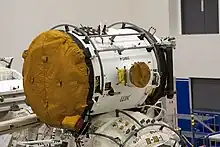
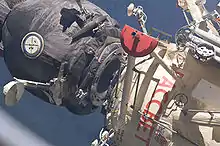
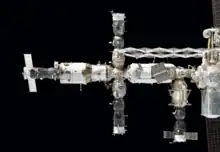
The module was designed and built by S.P. Korolev Rocket and Space Corporation Energia, from the already-made pressurized hull of the mock-up for dynamic tests of the cancelled Science Power Platform.[8][9]
On 17 December 2009, an Antonov An-124 carrying the Rassvet Module and ground process equipment arrived at the Kennedy Space Center in Florida.[10] Upon unloading, the equipment was delivered to a prelaunch processing facility run by the Astrotech. Energia specialists and technicians continued their work on the processing of the Rassvet module at the facility, completing stand-alone electrical tests and leak tests of the module and the airlock. They also prepared the airlock and the radiative heat exchanger for installation onto Rassvet. The module was moved to NASA's Space Station Processing Facility on 2 April 2010. After completing the final touches, it was placed into the shuttle payload transporter on 5 April 2010. The payload canister containing the Rassvet Module arrived at LC-39A on 15 April 2010.[11]
Engineers at Launch Pad 39A preparing Space Shuttle Atlantis had noticed paint peeling from the MRM-1 module. Although the problem was declared to have no impact on the operation of Rassvet, it posed a potential threat of releasing debris on orbit.[12]
Visited spacecraft
Rassvet was connected to nadir port of Zarya on 18 May 2010.[3]
| Spacecraft | Docking | Undocking |
| Soyuz TMA-19 | 28 June 2010 03:38 UTC | 26 November 2010 01:23 UTC |
| Soyuz TMA-20 | 17 December 2010 20:12 UTC | 23 May 2011 21:35 UTC |
| Soyuz TMA-02M | 9 June 2011 21:18 UTC | 21 November 2011 23:00 UTC |
| Soyuz TMA-03M | 23 December 2011 15:19 UTC | 1 July 2012 04:48 UTC |
| Soyuz TMA-05M | 17 July 2012 04:51 UTC | 18 November 2012 22:26 UTC |
| Soyuz TMA-07M | 21 December 2012 14:09 UTC | 13 May 2013 23:08 UTC |
| Soyuz TMA-09M | 29 May 2013 02:10 UTC | 10 November 2013 23:26 UTC |
| Soyuz TMA-11M | 7 November 2013 10:27 UTC | 13 May 2014 22:36 UTC |
| Soyuz TMA-13M | 29 May 2014 19:57 UTC | 10 November 2014 00:31 UTC |
| Soyuz TMA-15M | 23 November 2014 01:01 UTC | 11 June 2015 10:20 UTC |
| Soyuz TMA-17M | 23 July 2015 02:45 UTC | 11 December 2015 09:49 UTC |
| Soyuz TMA-19M | 15 December 2015 17:33 UTC | 18 June 2016 05:52 UTC |
| Soyuz MS-01 | 9 July 2016 04:12 UTC[13] | 30 October 2016 03:58 UTC[14] |
| Soyuz MS-03 | 19 November 2016 21:58 UTC | 2 June 2017 10:47 UTC |
| Soyuz MS-05 | 28 July 2017 21:54 UTC[15] | 14 December 2017 05:14 UTC[15] |
| Soyuz MS-07 | 19 December 2017 08:39 UTC | 3 June 2018 09:16 UTC |
| Soyuz MS-09 | 8 June 2018 13:01 UTC | 20 December 2018 01:42 UTC |
| Soyuz MS-12 | 15 March 2019 01:01 UTC | 03 October 2019 07:37 UTC |
| Soyuz MS-17 | 14 October 2020 08:48 UTC | 19 March 2021 16:38 UTC |
| Soyuz MS-18 | 9 April 2021 11:55 UTC | 28 September 2021 12:21 UTC |
| Soyuz MS-19 | 5 October 2021 12:22 UTC | 30 March 2022 07:21:11 UTC |
| Soyuz MS-22 | 21 September 2022 17:06 UTC | 28 March 2023 9:57 UTC |
| Soyuz MS-24 | 15 September 2023 | March 2024 (planned) |
| Soyuz MS-26 | September 2024 | March 2025 (planned) |
Gallery
 MRM-1 at the Astrotech Facility
MRM-1 at the Astrotech Facility Rassvet module development
Rassvet module development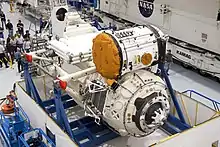 Rassvet Module
Rassvet Module
See also
References
- ↑ "Space Shuttle Mission STS 132 Press Kit" (PDF). NASA. May 2010. Retrieved 10 May 2010.
 This article incorporates text from this source, which is in the public domain.
This article incorporates text from this source, which is in the public domain. - ↑ Gebhardt, Chris (9 April 2009). "STS-132: PRCB baselines Atlantis' mission to deliver Russia's MRM-1". NASASpaceFlight.com. Retrieved 12 November 2009.
- 1 2 "STS-132 MCC Status Report #09". NASA. 18 May 2010. Retrieved 7 July 2010.
 This article incorporates text from this source, which is in the public domain.
This article incorporates text from this source, which is in the public domain. - ↑ "STS-132 MCC Status Report #13". NASA. 20 May 2010. Retrieved 7 July 2010.
 This article incorporates text from this source, which is in the public domain.
This article incorporates text from this source, which is in the public domain. - ↑ Ray, Justin (28 June 2010). "Station Crew Takes Soyuz for 'Spin around the Block'". SpaceFlight Now. Retrieved 7 July 2010.
- ↑ "MRM-1 for ISS". NASASpaceFlight.com. 11 April 2007. Retrieved 5 December 2012.
- ↑ "NASA Extends Contract With Russia's Federal Space Agency". NASA.
 This article incorporates text from this source, which is in the public domain.
This article incorporates text from this source, which is in the public domain. - ↑ NASA оплатило полёты своих астронавтов до 2011 года Novosti Kosmonavtiki №2007/6
- ↑ Justin Ray (25 March 2010). "Russian space module set for American launch aboard the shuttle Atlantis". Spaceflight Now. Retrieved 31 March 2010.
- ↑ "Mini-Research Module MRM1 At Cape For Shuttle Processing". 30 December 2009. Retrieved 6 March 2010.
- ↑ Ray, Justin (15 April 2010). "Russian space station module shipped to NASA's space shuttle launch pad". Spaceflight Now. Retrieved 25 April 2010.
- ↑ Bergin, Chris (28 April 2010). "STS-132: Managers Work through SSP FRR – Will Slip Launch Date If Required". NASASpaceFlight.com. Retrieved 29 April 2010.
- ↑ "Next Station Crew Arrives at Launch Site – Space Station". blogs.nasa.gov.
 This article incorporates text from this source, which is in the public domain.
This article incorporates text from this source, which is in the public domain. - ↑ "Soyuz MS crew return". Roscosmos. Retrieved 30 October 2016.
- 1 2 Richardson, Derek (28 July 2017). "ISS crew size increases to 6 with Soyuz MS-05 docking". Spaceflight Insider. Retrieved 29 July 2017.
